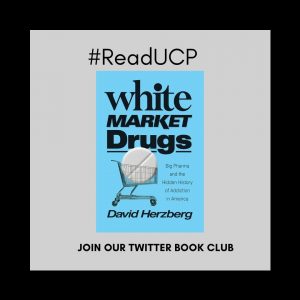Read an Excerpt from “White Market Drugs” Our Winter #ReadUCP Book Club Pick
We’re excited to share that our winter Twitter Book Club pick is David Herzberg’s White Market Drugs: Big Pharma and The Hidden History of Addiction in America. To get you started, we’ve included a short excerpt from the Introduction below. Then, order the book for 30% off with the code READUCP on our website, and join us on Twitter for a conversation with David on February 23 at 2:00 PM Central. Follow the hashtag #ReadUCP for updates.

Thinking past the medicine-drug divide
White markets are an open secret of American history, widely ac- knowledged but rarely examined in depth. This is, in part, because they fall into a scholarly gap between historians who study medicines and historians who study drugs. These are different people, who belong to different scholarly societies, each with their own journals and conferences, and who organize their research around their own distinctive questions. Addictive medicines sit directly in the gap between these groups and fit only awkwardly into either. Not all historians respect this boundary between medicines and drugs; a number of excellent works tell key parts of the story.11 Yet much of the story has not been told. Pharmaceutical opioids do not yet have their historian, for example, and despite good biographies of individual classes of drugs, the broader significance of white markets as a whole has not been explored.
From the vantage point of white markets, medicines and drugs appear not as separate things but as parts of a single, complex whole. America has not really had one set of “pharmaceutical regulations” and another set of “drug controls”; instead, it has had a single, divided regulatory system that unequally governs access to psychoactive substances. This system was built in the wake of the first white market crisis in the late nineteenth century and was consolidated with the establishment of the FDA and the FBN in the early twentieth century. Since then their stories have marched together in lockstep, with major developments on one side nearly always echoed by major developments on the other.12 This is because the dividing line between medicines and drugs is not a premise but a product of their history, continually renewed and renegotiated. Many drugs, and many types of drug use, have been dragged back and forth across the line—or maybe the dividing line has been dragged back and forth across them. How the line has been drawn at any given point was a social construction—the product of political struggle—but one with real and sometimes life-or-death consequences for consumers both within and outside of white markets.
A central argument of this book is that, most of the time, the division between medicines and drugs has not been effective. It has been an obstacle rather than an aid in protecting the public health. The presumption of therapeutic intent, fiercely promoted by drug companies and the health professions, has protected white markets from the robust regulation needed for such addictive, dangerous, and profitable products. The result has been a boom-bust sales cycle accompanied by a series of devastating public health crises. Meanwhile, the presumption that all nonmedical drug use is illegitimate and harmful has encouraged a long-running punitive anti-drug war with similarly devastating consequences on communities already hard hit by social inequality and, often, by the harms associated with illegal and thus unregulated drug sales. The twenty-first century’s twin crises are just the most recent, severe manifestation of this recurring problem with America’s divided approach to drugs and addiction. To repair and prevent this destructive cycle, I argue, requires knowing and then transcending the history that has built it. I hope this book can be part of that project.
David Herzberg is associate professor of history at the University at Buffalo. He is the author of Happy Pills in America: From Miltown to Prozac